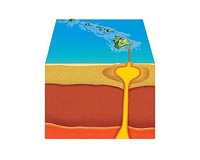| . |  |
. |
Brookings SD (SPX) Dec 08, 2009 South Dakota State University researchers and their colleagues elsewhere in America and in France have found compelling evidence of a previously undocumented large volcanic eruption that occurred exactly 200 years ago, in 1809. The discovery helps explain the record cold decade from 1810-1819. Researchers made the finding by analyzing chemicals in ice samples from snow-capped Antarctica and Greenland in the Arctic. The year-by-year accumulation of snow in the polar ice sheets records what is going on in the atmosphere. "We found large amounts of volcanic sulfuric acid in the snow layers of 1809 and 1810 in both Greenland and Antarctica," said Professor Jihong Cole-Dai of SDSU's Department of Chemistry and Biochemistry, the lead author in an article published in the scientific journal Geophysical Research Letters. Cole-Dai said climate records show that not only were 1816 - the so-called "year without a summer"- and the following years very cold, the entire decade of 1810-1819 is probably the coldest for at least the past 500 years. Scientists have long been aware that the massive and violent eruption in 1815 of an Indonesian volcano called Tambora, which killed more than 88,000 people in Indonesia, had caused the worldwide cold weather in 1816 and after. Volcanic eruptions have a cooling effect on the planet because they release sulfur gases into the atmosphere that form sulfuric acid aerosols that block sunlight. But the cold temperatures in the early part of the decade, before that eruption, suggest Tambora alone could not have caused the climatic changes of the decade. "Our new evidence is that the volcanic sulfuric acid came down at the opposite poles at precisely the same time, and this means that the sulfate is from a single, large eruption of a volcano in 1809," Cole-Dai said. "The Tambora eruption and the undocumented 1809 eruption are together responsible for the unusually cold decade." Cole-Dai said the Tambora eruption was immense, sending about 100 million tons of sulfur gas into the atmosphere, but the ice core samples suggest the 1809 eruption was also very large - perhaps half the size of Tambora - and would also have cooled the earth for a few years. The researchers reason that, because the sulfuric acid is found in the ice from both polar regions, the eruption probably occurred in the tropics, as Tambora did, where wind patterns could carry volcanic material to the entire world, including both poles. Cole-Dai said the research specifically looked for and found a special indicator of sulfuric acid produced from the volcanic sulfur gas in the stratosphere. The special indicator is an unusual make-up of sulfur isotopes in the volcanic sulfuric acid. Isotopes are different types of atoms of the same chemical element, each having a different number of neutrons, but the same number of protons. The unique sulfur isotope composition is like a fingerprint of volcanic material that has reached the stratosphere, said Cole-Dai. The stratosphere is the second major layer of the Earth's atmosphere, reaching from about six miles to about 30 miles above the Earth's surface at moderate latitudes. To impact global climate, rather than local weather, the sulfur gas of a volcanic eruption has to reach up into the stratosphere and once there, be spread around the globe. Cole-Dai's co-authors of the article are SDSU post-doctoral researcher David Ferris and graduate student Alyson Lanciki; Jo�l Savarino of the Laboratoire de Glaciologie et Geophysique de l'Environment in Grenoble, France; Melanie Baroni of CEREGE (Le Centre Europeen de Recherche et d'Enseignement des Geosciences de l'Environnement) at L'Universite Paul Cezanne in Aix-en-Provence, France; and Mark H. Thiemens of the University of California, San Diego. The National Science Foundation funded the research. Share This Article With Planet Earth
Related Links South Dakota State University Bringing Order To A World Of Disasters When the Earth Quakes A world of storm and tempest
 New Research Uncovers Deep Origins Of 'Hawaiian Hotspot'
New Research Uncovers Deep Origins Of 'Hawaiian Hotspot'San Diego (SPX) Dec 07, 2009 A new study by an international research team has opened up a window into the earth to reveal Hawaii's deep roots and the best picture yet of a plume originating from the lower mantle. The findings suggest that the Hawaiian hot spot is the result of an upwelling high-temperature plume from the lower mantle. The project, called the Plume-Lithosphere Undersea Melt Experiment (PLUME) ... read more |
|
| The content herein, unless otherwise known to be public domain, are Copyright 1995-2009 - SpaceDaily. AFP and UPI Wire Stories are copyright Agence France-Presse and United Press International. ESA Portal Reports are copyright European Space Agency. All NASA sourced material is public domain. Additional copyrights may apply in whole or part to other bona fide parties. Advertising does not imply endorsement,agreement or approval of any opinions, statements or information provided by SpaceDaily on any Web page published or hosted by SpaceDaily. Privacy Statement |